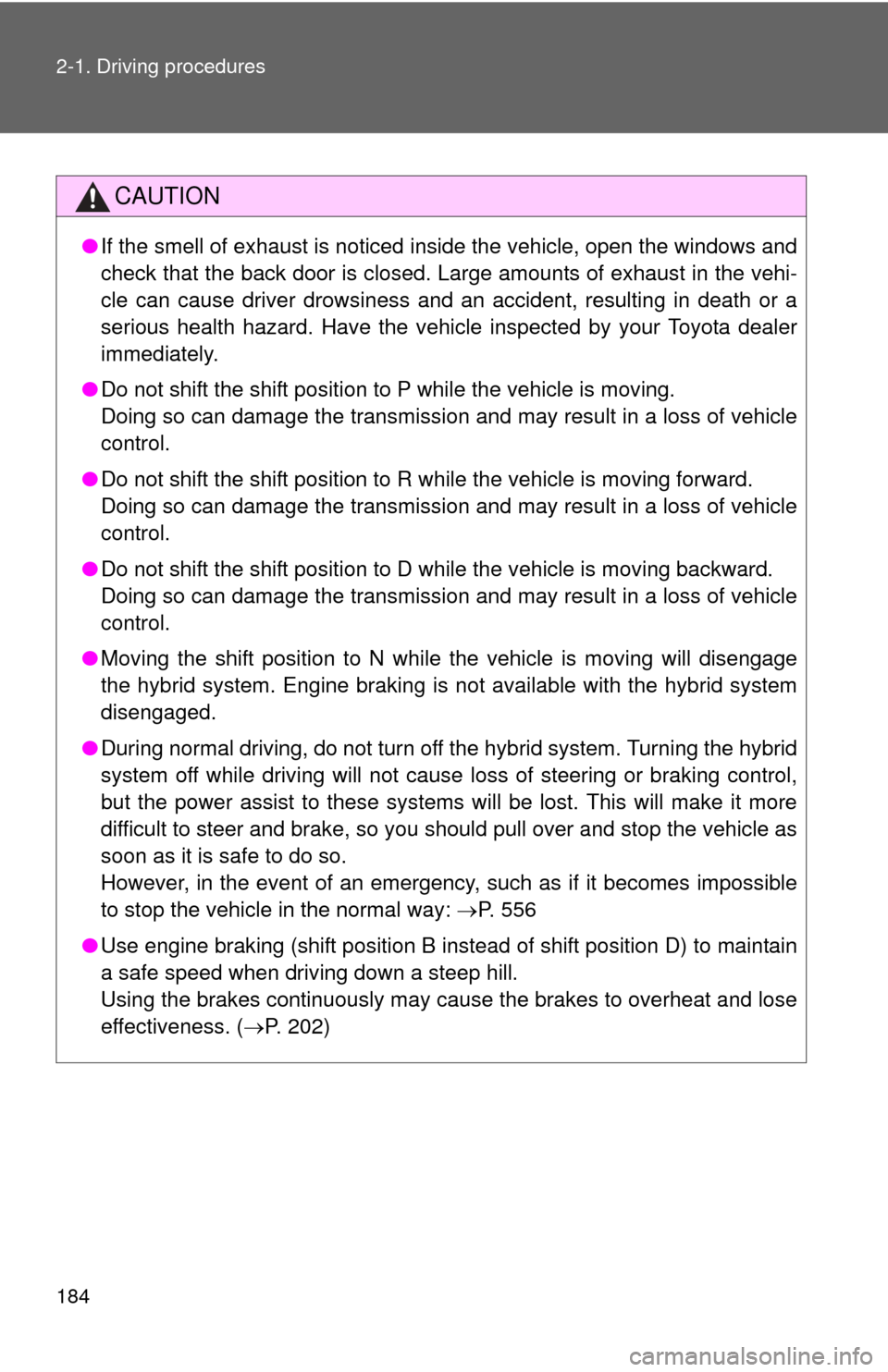Page 3 of 636

1
2
3
4
5
6
7
3
2-1. Driving proceduresDriving the vehicle............... 180
Power (ignition) switch ........ 192
EV drive mode .................... 199
Hybrid transmission ............ 202
Turn signal lever ................. 211
Parking brake ...................... 212
Horn .................................... 213
2-2. Instrument cluster Gauges and meters ............ 214
Indicators and warning lights ................................. 219
Multi-information display ..... 223
Head-up display .................. 243
2-3. Operating the lights and windshield wipers
Headlight switch .................. 250
Fog light switch ................... 256
Windshield wipers and washer .............................. 258
Rear window wiper and washer .............................. 262
Headlight cleaner switch ..... 265 2-4. Using other driving systems
Cruise control ..................... 266
Dynamic radar cruise control .............................. 270
LKA (Lane-Keeping Assist) .............................. 286
Driving assist systems ........ 296
Hill-start assist control ........ 301
PCS (Pre-Collision System) ............................ 303
2-5. Driving information Cargo and luggage ............. 311
Vehicle load limits............... 316
Winter driving tips ............... 317
Trailer towing ...................... 322
Dinghy towing ..................... 323
2When driving
Page 34 of 636

34 1-1. Hybrid system
■Sounds and vibrations specific to a hybrid vehicle
There may be no engine sounds or vibration even though the vehicle is able
to move. For safety, apply the parking brake and make sure to shift the shift
position to P when parked.
The following sounds or vibrations may occur when the hybrid system is
operating and are not a malfunction:
●The brake system operation sound heard from the front of the vehicle
when the driver’s door is opened.
● Motor sounds may be heard from the engine compartment.
● Sounds may be heard from the hybrid battery (traction battery) when the
hybrid system starts or stops.
● Sounds may be heard from the transmission when the gasoline engine
starts or stops, when driving at low speeds, or during idling.
● Engine sounds may be heard when accelerating sharply.
● Sounds may be heard due to regenerative braking when the brake pedal
is depressed and accelerator is loosened.
● Other sounds, such as motors and mechanical noises, may be heard
from the brake system when the brake pedal is depressed.
● Vibration may be felt when the gasoline engine starts or stops.
● Cooling fan sounds may be heard from the air intake vent. (
P. 37)
● The operation sound of the air conditioning system (air conditioning com-
pressor, blower motor).
Page 179 of 636

When driving2
179
2-1. Driving proceduresDriving the vehicle............ 180
Power (ignition) switch ..... 192
EV drive mode ................. 199
Hybrid transmission ......... 202
Turn signal lever .............. 211
Parking brake ................... 212
Horn ................................. 213
2-2. Instrument cluster Gauges and meters ......... 214
Indicators and warning lights .............................. 219
Multi-information display............................ 223
Head-up display ............... 243 2-3. Operating the lights and
windshield wipers
Headlight switch ............... 250
Fog light switch ................ 256
Windshield wipers and washer ........................... 258
Rear window wiper and washer ........................... 262
Headlight cleaner switch ............................. 265
2-4. Using other driving systems Cruise control ................... 266
Dynamic radar cruise control ............................ 270
LKA (Lane-Keeping Assist) ............................ 286
Driving assist systems ..... 296
Hill-start assist control ...... 301
PCS (Pre-Collision System).......................... 303
2-5. Driving information Cargo and luggage .......... 311
Vehicle load limits ............ 316
Winter driving tips ............ 317
Trailer towing ................... 322
Dinghy towing .................. 323
Page 184 of 636

184 2-1. Driving procedures
CAUTION
●If the smell of exhaust is noticed inside the vehicle, open the windows and
check that the back door is closed. Large amounts of exhaust in the vehi-
cle can cause driver drowsiness and an accident, resulting in death or a
serious health hazard. Have the vehicle inspected by your Toyota dealer
immediately.
● Do not shift the shift position to P while the vehicle is moving.
Doing so can damage the transmission and may result in a loss of vehicle\
control.
● Do not shift the shift position to R while the vehicle is moving forward.
Doing so can damage the transmission and may result in a loss of vehicle\
control.
● Do not shift the shift position to D while the vehicle is moving backward.
Doing so can damage the transmission and may result in a loss of vehicle\
control.
● Moving the shift position to N while the vehicle is moving will disengage
the hybrid system. Engine braking is not available with the hybrid system
disengaged.
● During normal driving, do not turn off the hybrid system. Turning the hybrid
system off while driving will not cause loss of steering or braking control,
but the power assist to these systems will be lost. This will make it more
difficult to steer and brake, so you should pull over and stop the vehicle as
soon as it is safe to do so.
However, in the event of an emergency, such as if it becomes impossible
to stop the vehicle in the normal way: P. 556
● Use engine braking (shift position B instead of shift position D) to maintain
a safe speed when driving down a steep hill.
Using the brakes continuously may cause the brakes to overheat and lose
effectiveness. ( P. 202)
Page 191 of 636

191
2-1. Driving procedures
2
When driving
NOTICE
■
When encountering flooded roads
Do not drive on a road that has flooded after heavy rain etc. Doing so may
cause the following serious damage to the vehicle:
●Engine stalling
● Short in electrical components
● Engine damage caused by water immersion
In the event that you drive on a flooded road and the vehicle is flooded, be
sure to have your Toyota dealer check the following:
● Brake function
● Changes in quantity and quality of engine oil, transmission fluid for the
hybrid system, etc.
● Lubricant condition for the bearings and suspension joints (where possi-
ble), and the function of all joints, bearings, etc.
If the P position control system is damaged by flooding, it may not be possi-
ble to shift the shift position to P, or from P to other positions. When the shift
position cannot be changed from P to any other position, the front wheels
will lock, and you will be unable to tow the vehicle with the front wheels on
the ground, as the front wheels may be locked. In this case, transport the
vehicle with both front wheels or all four wheels lifted.
Page 202 of 636
202
2-1. Driving procedures
Hybrid transmission
Select a shift position appropriate for the driving conditions.
■Shifting the shift lever
Shift lever
Operate the shift lever gently and ensure correct shifting operation.
When shifting to the D or R positions, move the shift lever
along the shift gate.
To shift to the N position, slide the shift lever to the left and hold
it. The shift position will change to N.
Shifting to B is only possible when shift position D is selected.
The shift lever will always return to this original position after a
shifting operation.
When shifting from P to N, D or R, from D to R, or from R to D, ensure
that the brake pedal is being depressed and the vehicle is stationary.
Page 406 of 636
406 4-2. Maintenance
Luggage compartment
Vehicle interior
ItemsCheck points
12-volt battery Check the connections. ( P. 431)
ItemsCheck points
Accelerator pedal
• The accelerator pedal should
move smoothly (without uneven
pedal effort or catching).
Hybrid transmission “Park” mech-
anism • When parked on a slope and the
shift position is in P, is the vehicle
securely stopped?
Brake pedal • Does the brake pedal move
smoothly?
• Does the brake pedal have appro- priate clearance from the floor?
(P. 568)
• Does the brake pedal have the correct amount of free play?
(P. 568)
Brakes • The vehicle should not pull to one
side when the brakes are applied.
• The brakes should work effec- tively.
• The brake pedal should not feel spongy.
• The brake pedal should not get too close to the floor when the
brakes are applied.
Page 464 of 636
464 4-3. Do-it-yourself maintenance
FUSEAmpereCircuit
25 RR WIP 20A Rear window wiper and washer
26 WIP 30A Windshield wipers
27 MET 7.5A Gauges and meters
28 IGN 10ABrake system, driver support sys-
tem, multiport fuel injection sys-
tem/sequential multiport fuel
injection system, SRS airbag sys-
tem, front passenger occupant
classification system (ECU and
sensors), power management sys-
tem, smart key system, front pas-
senger’s seat belt reminder light
29 PANEL 10AAir conditioning system, personal
light, transmission, P position
switch, navigation system, Solar
Ventilation System, Remote Air
Conditioning System, advanced
parking guidance system, head-
light cleaner, front passenger’s
seat belt reminder light, headlight
leveling system, glove box light,
clock, audio system, MPH or km/h
switch
30 TAIL 10AHeadlight leveling system, park-
ing lights, tail lights, license plate
lights, front fog lights, side marker
lights